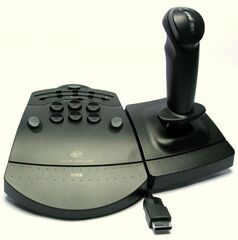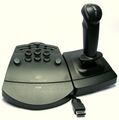Mission Stick
From Sega Retro

| |||||
| Mission Stick | |||||
|---|---|---|---|---|---|
| Made for: Sega Saturn | |||||
| Manufacturer: Sega | |||||
|
The Sega Mission Stick, called the Analog Mission Stick (アナログミッションスティック) in Japan, is an analog stick, with the usual Sega Saturn buttons (which can be flipped to the left or the right of the stick), as well as trigger buttons on the stick. Interestingly enough, there's an expansion connector on the bottom of the stick, as well as support for mounting something else on the opposite side of the stick from the button panel. This allows the user to switch the stick to the other side of the central base unit. The expansion connector had no official use, but has a hidden function: if you have two Mission Sticks, and detach the second stick from its base unit and attach it to the other side of the first base unit, and plug that stick into the "Sub Control" port on the bottom of the base unit, and you've got a twin-stick. Only one game, Panzer Dragoon Zwei, is known to support that twin-stick mode; all others only support the Main Control port. It is important to note that the Mission Stick in twin-stick mode is not compatible with the Virtual-On twinstick; it's its own thing.
The Mission Stick was also one of the more expensive Saturn control peripherals, and (as far as Japan goes) very few games supported it. However, most games that support the Arcade Racer Joystick will also work in analog mode on the Mission Stick, and particularly in Western markets some games do support it that don't mention that fact anywhere on the games' packaging or indeed even in the games, such as in the case of MechWarrior 2: 31st Century Combat, so its library isn't quite as small as it appears.
Because of design differences from the regular digital control pad, not all games will recognize the Mission Stick. For instance, Tunnel B1 will not work at all with a Mission Stick attached. Furthermore, certain games, such as Solar Eclipse will ignore custom button configurations. It will work in some capacity with most Saturn games, however.
In Japan, the controller has model number HSS-0114 and was released on 29 September 1995 and retailed at ¥7,800.
List of supported games
- Note: this list omits non-Japanese games and may use Japanese names instead of western ones. Please expand/fix as needed, this list is not complete.
- Black Dawn
- Black Fire
- Crimewave
- Cyber Speedway
- Fuusui Sensei
- G Vector
- Ghen War
- MechWarrior 2: 31st Century Combat
- Midway Presents Arcade's Greatest Hits: The Atari Collection 1
- Night Striker S
- NiGHTS into Dreams
- Panzer Dragoon
- "Panzer Dragoon Zwei"
- Sega Ages: Volume 1
- Sega Ages After Burner II
- Sega Ages Galaxy Force II
- Sega Ages VOL.2: Space Harrier
- Sega Rally Championship
- Sky Target
- Soukyugurentai
- Soviet Strike
- StarFighter 3000
- Road & Track Presents The Need for Speed
- Thunderhawk II
- Wing Arms
Gallery
Physical Scans
JP box (Sega Ages Space Harrier bundle) (front)
External Links




